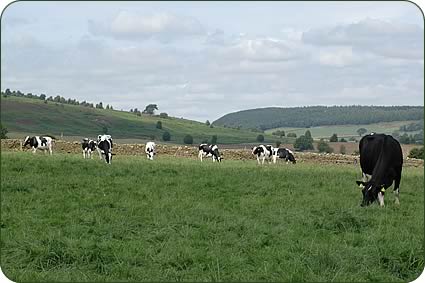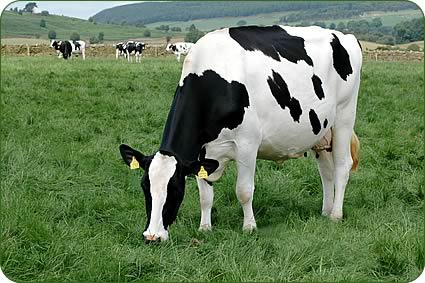Jennifer MacKenzie is an agricultural photo journalist with almost 30 year's experience. Operating from her base in Cumbria, Jennifer undertakes mainly industry-related freelance writing and photography.
Pedigree Holstein Sales buoyant
Pedigree Holstein dairy cattle sold at auction in the UK continue to command excellent prices even though the commercial buyers who re underpinning the market are receiving low milk prices.
 |
| Demand for UK-bred dairy cattle has been further buoyed by the realisation that they are equal in genetic quality, if not superior, to imported cattle. |
Key to this is supply and demand with a number of factors affecting this demand depending partly on geographical influences.
Six years ago, pre the UK’s 2001 foot and mouth epidemic, pedigree dairy cows and heifers at auction were making anything from 50 to 70 per cent of prices currently being achieved.
Holstein UK club sales across the country reflect the upturn. The January 2006 sale for the Border and Lakeland Club at Borderway Mart, Carlisle, Cumbria, was a total sell-out averaging nearly £1,150 for all cows and heifers with six making over 1,500gns and two over 2,000gns.
At the following month’s sale 61 animals averaged £1,110 to a top price of 2,000gns.
Yet at the equivalent January sale in 2000, the average for 11 heifers was £489 with a leading price of 800gns and the May sale that year averaged £588 for 101 cows.
Similarly at auctioneers’ Norton and Brooksbank’s first Lancashire club sale of 2006 in January at Lancaster, in Lancashire, 76 head averaged £1,143 selling to 4,000gns, the highest price for some time.
Likewise the Western Holstein Club’s sale conducted by Wright-Manley in Beeston Castle, Shropshire, at the end of January averaged £1,157 for 80 head with a top price of 2,000gns.
Pedigree Holstein registrations by its breeders’ society HUK have remained static at 220,000 a year for the last four years against a trend of decreasing membership.
“There’s just a shortage of dairy replacements,” said Jean Gould who with her husband Mick, a HUK council member, is a regular consignor of newly-calved heifers with consistently good milk production from their Woodmarsh herd at Bomere Heath in Shropshire at the Beeston Castle sales.
“Commercial dairy producers are using the beef bull to produce finishing cattle. They have filled up with milkers to increase their herds and they haven’t room to rear dairy replacements.
“It’s an issue of supply and demand. It’s not the price of milk that’s creating it – these producers have not got a lot of money in their pocket to buy these cattle,” said Mrs Gould.
 |
“There’s just a shortage of dairy replacements”. |
Depending on contract, UK milk prices vary between an average 17p and 20p per litre, around 10p per litre less than in the 1990s after de-regulation of the milk market, and dairy companies continue to chip away at today’s farmgate prices.
Pedigree dairy auctioneer David Jones, who also runs his own pedigree Holstein Wiltor herd in Chepstow, Monmouthshire, South Wales, is involved with sales across the country and says higher herd replacement rates are placing an increasing demand on the market place.
As well as today’s high production cows having an influence on replacements, diseases such as Johnes, BVD (Bovine Viral Diarrhoea) and increasingly TB affecting whole herds particularly in the South West are taking their toll, he said.
“Couple this with the fact that herds have got larger and replacement rates as a result are growing. Putting on another hundred cows means you have got to find replacements for those cows.
“Producers have been expanding because the costs of running the business are increasing while current milk quota costs are low and it’s a way of generating more income. It’s all down to economics.”
Carlisle dairy auctioneer Glyn Lucas agrees that dairy farmers are looking at the current economics and they are capitalising on low quota prices to fill national quota which is under production for the second year running.
The return of the market for cull cows with an 880kg cow fetching £500 and the prospects of achieving up to £650 a head with the opening of export markets was also underpinning trade for dairy replacements.
“A high percentage of buyers of these pedigree females are commercial producers wanting replacements, many of them now milking upwards of 200 cows, some 500 cows, who are looking at 20 per cent replacement rates compared with say five to seven per cent for a 60-cow herd.
“The main supplier of replacements was the smaller herd but they have disappeared, pushing up the price. I can’t see the situation changing for the foreseeable future.”
Defra’s recently published table of TB compensation rates for dairy cows he believes is likely to have little influence on commercially sought-after pedigree dairy stock.
The bonus for non-registered producers buying pedigree cattle lies in the cow family history and production figures, he says.
“Some buyers will pay attention to a particular sire but they are also looking for animals that have longevity on their side so they are looking at the pedigrees to find cow families which have been proven to give a lot of clean, healthy milk over at least three or four lactations.
“If you can see from the pedigree that the family has been profitable that’s worth a lot of money. After all, they are in the herd to produce the white stuff.”
Holstein UK’s Simon Gee added that purchasers of pedigree Holsteins were guaranteed the provenance of the product. “It provides the ultimate in farm assurance and traceability.”
Demand for UK-bred dairy cattle has been further buoyed by the realisation that they are equal in genetic quality, if not superior, to imported cattle.
“We have noticed a renewed interest in pedigree dairy cattle since foot and mouth. While a lot of our pedigree breeders run their herds on commercial basis, more non-registered breeders have invested in some pedigree animals and they are finding an interest that they had not realised before,” he says.
“These commercial producers may be milking 200 to 300 cattle but perhaps registering half a dozen, recognising their potential value and seeing scope for adding to cash flow with sales of progeny.”

